Look Similar
Francolin and spurfowl were for a long time all referred to as francolin. Although the birds all look similar scientists have discovered that they are not even that closely related.
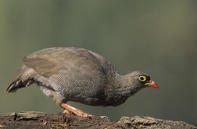
Broadly speaking, a francolin is smaller and has yellow legs. It flushes when disturbed from the open areas where it lives and has a musical call. A spurfowl is larger and has orange, red or black legs. It sits tight or runs when disturbed (rather than flushing) and roosts in trees at night. Spurfowl have harsh calls.
The name ‘spurfowl’ is derived from the backwards-facing spurs on its heels. These are believed to be used for dualling during courtship battles between males.
Covey’s

Groups of francolin and spurfowl are known as coveys. Usually, the group consists of a monogamous pair and its offspring which like most ground birds are precocial from hatching and accompany the parents wherever they go soon after hatching.
The young can fly within ten days which is trait required only in extreme circumstances or for roosting out of harm's way at night. When a bird gives the alarm, the covey will fly up noisily and scatter.
They do not fly far before landing and taking to thick cover (spurfowl fly only as a last resort). Young chicks may scatter and lie flat at the parent’s alarm relying on their cryptic colour to conceal them. The members of a covey reunite after dispersing by using a high-pitched ventriloquial call.
Omnivorous Feeders
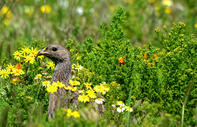
Francolin and spurfowl are fairly omnivorous in their habits and feed on bulbs, seeds, berries, shoots insects and molluscs. They typically use their bills and feet to scratch around in the leaf litter under vegetation to find food.
They produce large droppings for their size which are usually round and slightly smaller than a golf ball. These are smelly due to the omnivorous content. Like other birds, the darker body of the dung is coated partly in white.
This is uric acid concentrated to conserve body water (and because a heavy water-filled bladder would not be conducive to flight). Birds have only one exit for reproductive and digestive evacuations known as the cloaca. The white from the urethra is added to the brown faeces on evacuation.
Although many of the species feed in bushy areas where they benefit from the cover to conceal them from aerial predators like African Hawk Eagles, francolin and spurfowl are often seen feeding on fallen grass seed alongside roads. They are conspicuous by their noisy calls and their habits of chasing one another.
This behaviour is thought to be connected to their breeding habits and the maintenance of a territory. Like other ground birds, francolin and spurfowl nest in rudimentary nests on the ground and they conceal their eggs with their own cryptically coloured bodies.
Crested Francolin
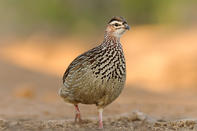
Crested francolin are very common francolins are the exception to the ‘francolin-spurfowl’ rule having the red legs of the spurfowl group and being prone to roosting in trees at night (not on the ground as other francolin do).
It also tends to flee danger at a run into thick vegetation rather than being primarily flushed like other francolin. When it does take to the sky it flies low and weaves between the trees until out of sight. Its small size and rhythmical (although not musical) call makes it a francolin.
Crested francolin are especially territorial and the monogamous pair proclaim their turf by use of a duet that supposedly sounds like they’re saying ‘Beer and cognac… beer and cognac…beer and cognac’. Outside of the breeding season, these birds may roam widely.
They prefer to forage under the cover of thick bush but give themselves away with their noisy habits of scratching in the leaf litter. They frequently disassemble elephant and rhino dung to access seeds and insects.
Coqui Francolin
Coqui francolin are the smallest francolin in the Lowveld region but are still fairly conspicuous by their loud and diagnostic call that announces ‘Co-qui…co-qui…co-qui’ as its onomatopoeic name suggests.
Pairs remain in particular areas and males will declare their territories by climbing to a high point like a tree stump or termite mound before calling. If flushed this francolin flies far and fast. Coqui francolins eat more fruit than other francolins and glean ticks off grass stalks.
Natal Spurfowl
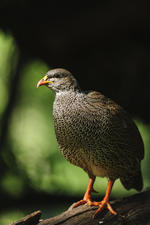
Natal spurfowl live in loose coveys of up to ten individuals and congregate at areas of good feeding but scatter readily if under threat. They may run away from disturbances or will flush noisily as individuals dropping into cover or onto a perch shortly where they freeze. The Natal Spurfowl has an especially raucous call and it vocalizes at dawn and dusk particularly.
It also employs a mewing contact call to reunite scattered individuals. Like the crested francolin, the natal spurfowl is notorious for scratching through elephant and rhino dung for undigested seeds.
Swainson's Spurfowl
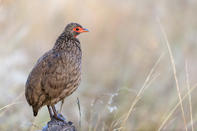
The Swainson’s spurfowl is a conspicuous species with a grating call especially emanated by males at dawn and dusk from their perches atop termite mounds.
They live in pairs or family groups and maintain contact through high-pitched mews. They rest during the heat of the day and unlike other spurfowl or francolin, will feed at night during hot times (provided the moon provides illumination). Swainson’s are fond of the waste grains on offer in agricultural lands.
They are particularly resolute when flushed taking to cover immediately and not rising up a second time no matter what. Swainson’s perch low down in trees at night and will typically drink before they go to roost.
By Megan Emmet